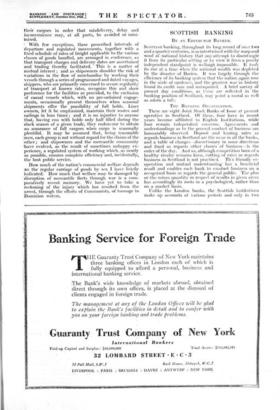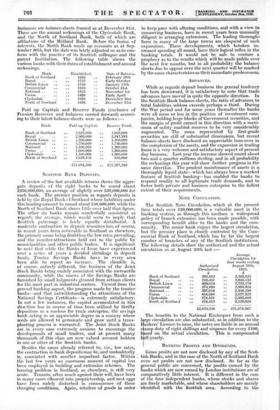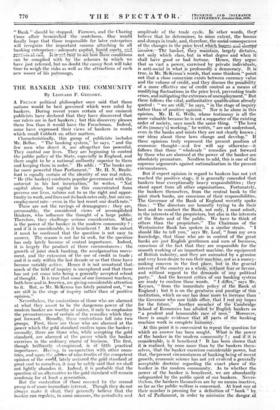SCOTTISH BANKING
By AN EDINBURGH BANKER.
Scowls"' banking, throughout its long record of over two and a quarter centuries, is so intertwined with the warp and woof of national history that any attempt to disentangle it from its particular setting or to view it from a purely independent standpoint is wellnigh impossible. It took its rise at a time when the national wealth was depleted by the disaster of Darien. It was largely through the efficiency of its banking system that the nation again rose in the scale of opulence, and the greatest war in history found its credit sure and unimpaired. A brief survey of present day conditions, as these are reflected in the banking position of. Scotland, may point a moral as well as adorn a tale.
THE BANKING ORGANIZATION.
There are eight Joint Stock Banks of Issue at present operative in Scotland. Of these, four have in recent years become affiliated to English Institutions, while four remain independent concerns. Agreements and understandings as to the general conduct of business arc honourably observed. Deposit and -lending rates as regards business in Scotland are the same in all the banks, and a table of charges—discretionary in some directions and fixed as regards other classes of business—is the order of the day. And so, although competition born of a healthy rivalry remains keen, cutting of rates as regards business in Scotland is not practised. • Th's friendly co- operation and mutual understanding has a beneficial result and enables each bank to conduct business on a recognized basis as regards the general public. The plus or the minus quantity in respect of results in given areas has accordingly its roots in a psychological, rather than on a market basis.
Unlike the London banks, the Scottish institutions make up accounts at various periods and only in two instances are balance-sheets framed as at December 31st. These are the annual reckonings of the Clydesdale Bank, and the North of Scotland Bank, both -of which are affiliations of the Midland Bank. Before the fusion of interests, the North Bank made up accounts as at Sep- tember 30th, but the date was lately adjusted so as to con- form with the practice of its Scottish colleague and the parent Institution. The following table shows the various banks with their dates of establishment and annual reckonings.
Bank.
Established.
Date of Balance.
Bank of Scotland . 1695 .. February 28th Royal .. .. 1727 .. Early October British Linen .. • • 1746
January 15th Commercial ..
1810
October 31st National ..
1825
November 1st Union
1830
Early April Clydesdale
1838
December 31st North of Scotland
1836 • • December 31st
Paid up Capitals and Reserve Funds (exclusive of Pension Reserves and balances carried forward) accord- ing to their latest balance-sheets were as follows :—
Bank. Paid-up Capital. Reserve Fund.
£
Bank of Scotland • • 1,325,000
• •
1,050,000 Royal ..
2,500,000
2,347,393 British Linen ..
1,250,000
1,500,000 Commercial ..
1,750,000
1,750,000 National • ..
1,100,000
1,300,000 Union
1,000,000
• •
1,300,000 Clydesdale ..
1,100,000
• •
1,300,000 North of Scotland • • 1,059,530
850,000
£11,084,500 .. £11,397,393
SCOTTISH BANK DEPOSITS.
A review of the last available returns shows the aggre- gate deposits of the eight banks to be round about £250,000,000, an average of slightly over £30,000,000 for each bank. The premier position as regards deposits is held by the Royal Bank of Scotland whose liabilities under this heading amount to round about £40,000,000, while the North of Scotland Bank shows little over half that figure. The other six banks remain wonderfully consistent as regards the average, which would seem to imply that Scottish patronage is fairly equally distributed. A moderate _ contraction in deposit resources has, of course, in recent years been noticeable in Scotland as elsewhere, the primary cause being dmibtless thelow rates prevailing, and the counter-attractions held out to the public by municipalities and other public bodies. It is significant to note that while the Banks of Issue have experienced over a series of years a decided shrinkage in deposit funds, Trustee Savings Banks have in every area been able to report an increase. The clientele is, of course, entirely different, the business of the Joint Stock Banks being mainly associated with the mercantile community, while the sinews of the Savings Banks are furnished by small lodgments gleaned from artisan clients for the most part in industrial centres. Viewed from the general banking aspect, the progress made by the trustee banks—and that notwithstanding the attractions of the National Savings Certificate—is extremely satisfactory. In not a few instances, the capital accumulated in this direction has in course of time been utilized by thrifty depositors as a nucleus for trade enterprise, the savings bank acting in an appreciable degree as a nursery where seeds are allowed to germinate and grow until a trans- planting process is warranted. The Joint Stock Banks are in every ease extremely anxious to encourage the developments of small traders, and at present many thousands of this class are now valued account holders in one or other of the Scottish banks.
Besides the cause already referred to, viz., low rites, the contraction in bank deposits may be; and undoubtedly _ is, associated with another important factor. Within _ the last few years an enormous amount of capital has been employed in building and extension schemes. The housing problem in Scotland, as elsewhere, is still very acute. Tenants, often much against their will, have been in many cases elbowed into proprietorship, and nest eggs have been rudely disturbed in consequence of these changing conditions. Again, retailers of goods in order to keep pace with altering conditions, and with a view to conserving business, have in recent years been unusually diligent in arranging extensions. The leading thorough-' fares in many of the large towns are eloquent of such expansions. These developments, which betoken in creased spending all round, have their logical reflex in the banking totals. It would not be safe to venture a prophecy as to the results which will be made public over the next few months, but in all probability the balance sheets due to appear over the next quarter will be marked by the same characteristics as their immediate predecessors.
ADVANCES.
While as regards deposit business the general tendency has been downward, it is satisfactory to note that trade advances have moved in quite the opposite direction. In the Scottish Bank balance-sheets, the ratio of advances to total liabilities seldom exceeds perhaps a third. During the War period and for some years thereafter the banks were all more or less in the position of investment com- panies, holding large blocks of Government securities, and the margin of profit earned in this direction with a maxi- mum of safety enabled reserves to be very considerably augmented. The sums represented by first-grade securities are still of substantial dimensions, but recent balance-sheets have disclosed an appreciable turn-over in the complexion of the assets, and the expansion in trading loans is a very welcome and satisfactory aspect of present day business. Last year the increase showed round about two and a quarter millions sterling, and in all probability the reckonings this year will show further progress in the same direction. The prudent maintenance of assets in a thoroughly liquid state—which has always been a marked feature of Scottish banking—has enabled the banks to respond readily to all legitimate trade demands, and to foster both private and business enterprise to the fullest extent of their requirements.
NOTE CIRCULATION.
The Scottish Note Circulation, which at the present time totals over £20,000,000, is a valuable asset in the banking system, as through this medium a widespread policy of branch extension has been made possible, with corresponding benefit alike to the banks and the com- munity. The senior bank enjoys the largest circulation, but the premier place is closely contested by the Com- mercial Bank of Scotland, which has by far the largest number of branches of any of the Scottish institutions. The following details show the authorized and the actual circulation as at August 29th last :—
Average Circulation for four weeks ending Authorized August 29th, Circulation. 1925.
£
£ Bank of Scotland
• •
396,852
3,203,825 Royal ..
• •
216,451
• •
2,653,135 British Linen ..
438,024
2,723,179 Commercial ..
374,880
• •
2,998,854 National - .
297,024
• •
2,356,238 Union ..
454,346
2,527,322 Clydesdale ..
274,321
• •
2,483,488 North of Scotland
224,452
• •
2,128,926
£2,676,350 .. £21,074,967
_ The benefits to the National Exchequer from such a trge circulation are also substantial, as in addition to the ankers' Licence to issue, the notes are liable in an annual p duty of eight shillings and sixpence for every £100, ed on the actual circulation. This is compounded BANKING PROFITS AND DIVIDENDS.
Gross profits are not now disclosed by any of the Scot- tish Banks, and in the.case of the North of Scotland Bank even net profits are not now disclosed. So far as the general public are concerned, the profits earned by the banks which are now owned by London institutions are of comparatively little interest. It is different in the case of the four independent banks, whose stocks and shares are freely marketable, and whose shareholders are mainly identified with the Scottish area. According to the latest reports the profits and distribution of these institu- tions were as follows ;--
Rate of Dividend.* Net Profit.
• • 365,475 - ' 16%
.. 452,369 15o/ 335,117{169 i on " le" shares 10% on " B " shams
• • 330,464 18% The yield per cent. at approximate prices works out as under :—
Approxi- mate
Divi- dend as
Bank. Share. Paid. Price. above.
Bank of Scotland.. £150 £100 346 16% Royal .. Stock £100 301 15%
Commercial— <4 A.
£20 £5 151 16%
B
£1 All 41/3 10% Union £5 £1 80/6 18%
FOREIGN EXCHANGE AND TRUSTEE BUSINESS.
During the last few years, special Acts of Parliament and Supplementary Charters in favour of Scottish banks have invested them with much wider powers, and under more fully defined and amended constitutions various developments have taken place. Foreign Exchange Departments are now important auxiliaries in each of the banks, and trustee business is also undertaken. The English office of Public Trustee having no counterpart in Scotland the gap is appreciably filled by the banks who are empowered to undertake this class of business. An important advantage attaching to this arrangement so far as estates are concerned lies in continuity of manage- ment, and in capacity to undertake satisfactorily the obligations involved. The fees charged for this class of business are on a very modest scale, and the knowledge that the administration of their estates may be perpetu- ated with efficiency and at a minimum of cost is a satis- factory arrangement to testators who have hitherto had to consider the possible contingency of lapsed trusts. While the bankers who undertake this class of business prefer to be sole nominees they do not object to act along with others, subject to certain stipulations conceived to be mutually beneficial. .
- BANKING EXTENSIONS.
One of the.most significant aspects of Scottish banking in recent years has been the enormous development of the branch systeni. Fifty years ago there were 880 bank offices in Scotland. To-day the number is round about 1,600, which gives an average of 200 for each bank. The largest branch system is that controlled by the Commercial Bank of Scotland, whose extensions have been planned on a definite and. well-considered scheme calculated to meet the needs of -a widespread clientele, and to stabilize a system which extends from Solway to Cape Wrath. Another important expansion, which reflects great credit on the enterprise of the Commercial Bank administration, was the breaking of new ground in the West Central area of London. For half a century, Scottish banks do not appear to have had any ambitions outside the Lombard Street area. The purchase of Drummond's business at Charing Cross by the Royal Bank in 1924, for the first time in history gave Scotland a footing west of Temple Bar, and the success of the enterprise was immediately reflected in the figures of the Royal Bank balance-sheet and the handsome appreciation in the value of its stock. Within the past few weeks, another Scottish Bank has concluded arrangements for opening a West End office, and the initial successes to which we have just referred may lead to still further developments. Scottish banking is already represented in England at both Berwick and Carlisle, with their adjacent areas, but apart from London it has not, so far, penetrated to any extent even the northern counties.
TRADE CONDITIONS AND OUTLOOK.
The great industries, especially those identified with the Glasgow district, viz., shipbuilding, engineering, coal and iron, are all more or less in a condition of acute depression, and the atmosphere of uncertainty which * These dividends are the latest announced and consequently show a slight variation from the dividends for the full financial year recorded on another page.—En.
. .
Bank of Scotland ..
Royal ..
Commercial..
Union .. Yield
of
£4 12 6
£4 19 9 £5 1 6 £4 17 0 £4 9 6
prevails here as elsewhere has its corresponding reaction. In some cases even preference dividends have been passed by important companies, and the outlook in most cases is obscure. Much depends upon a sane recognition by Labour of hard facts and the circumstances of the hour. At present, many !arc!? companies fiud it quite impossible to secure contracts at prices ruling, and large orders Have been placed elsewhere on terms more favourable to pur- chasers. The curious circumstance is that while the staple industries are languishing, retailers, judging from recent developments, would appear to be enjoying quite a profitable turn-over. The inference to be drawn from this is that the general public are spending freely—too freely perhaps, from a standpoint of healthy economics. Edinburgh may be cited as a typical example, its leading thoroughfares being seldom free of building scaffoldings associated with structural alterations, which must run into large figures, and all identified with the retail interest. Collateral with this expansion, several attractive bank offices have also been established. At present the East of Scotland, and the Forth area more especially, is somewhat perturbed over the Admiralty decision to reduce Rosyth dockyard to the level of a care and maintenance basis. This economy movement has been the subject of a good deal of criticism—well informed and otherwise—but probably no movement in the direction of conserving the national resources ever escapes the protests of the circle which it immediately concerns.
NATIONALIZATION OF BANKING.
Although history may not always repeat itself, there arc certain basic laws which operate over critical cycles, and in Scotland these have been well defined in the national experience. As we remarked at the outset of this article, Scottish banking took its rise at a time when the country was extremely poor, and the troubles of the seventeenth and eighteenth centuries, when the banking system was in its infancy, made the path very hard for the generations who reaped the follies of their predecessors. But the stern conditions of the times built the nursery in which Scottish thrift was reared, and the resources of the nation prudently administered through a capable banking system laid the foundations of a prosperity which is reflected not only in the cities of the north, but far beyond the national boundaries. The Scottish banks are the expression of the national life, and any attempt to super- sede their admitted efficiency by a State contrivance would be a blunder of the first magnitude. Arguments based on tradition may not be always cogent, but the delicate mechanism of a banking system which has its roots in mutual confidence and personal relationships would not readily adapt itself to a regime of State officialdom. A cast iron system would take the place of an organism in which competition is the life of trade, and of which the mainspring is the personal equation.
THE MUNICIPAL OFFSHOOT.
During recent years, the establishment in various districts of so-called municipal banks has been a develop- ment somewhat alien to the principles of sound finance. In some of the towns, " Banks " protected by limited liability have commenced operations on a capital of 2,000 shilling shares—their initial object being to provide cheap money to finance municipal undertakings. Deposits payable at call are freely invited at a rate of interest somewhat higher than that offered by the established banking concerns. No one questions the good intentiont of those indentified with these municipal enterprises, but responsible critics take exception, and reasonably sci, to the structure upon which they are being reared. The danger which lies ahead is that funds may be tied up in municipal undertakings, and that when the depositor demands his money it may not be available. Municipal borrowing in Scotland, as elsewhere, is of course of long standing, but the borrowing is generally for fixed periods, and in any event, the lender to a Corporation has the security of the rates behind his lodgment. Municipal bank depositors do not enjoy the legal security which attaches to first hand dealings, and therein lies the main objection, while the inadequate capital makes the whole scheme somewhat ludicrous. There is a strong feeling abroad that the indiscriminate use of the word " Bank " should be stopped. Farrows, and the Charing Cross affair besmirdiled' -the seuttheon. One would would- fondly hope that those responsible for later enterprises will recognize the important canons attaching to all banking enterprises=-adequate capital? liauid assets ..refer,":3; .c- J1. erity t.6-See how these conditions can be . complied with by the schemes to which we have just referred, but no doubt the canny Scot will take time to weigh the risks as well as the attractions of each new wooer of his patronage.

































































 Previous page
Previous page